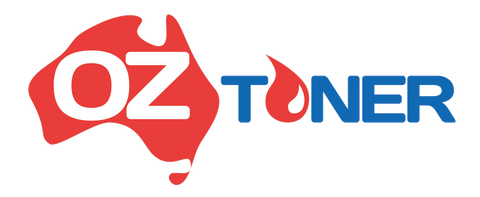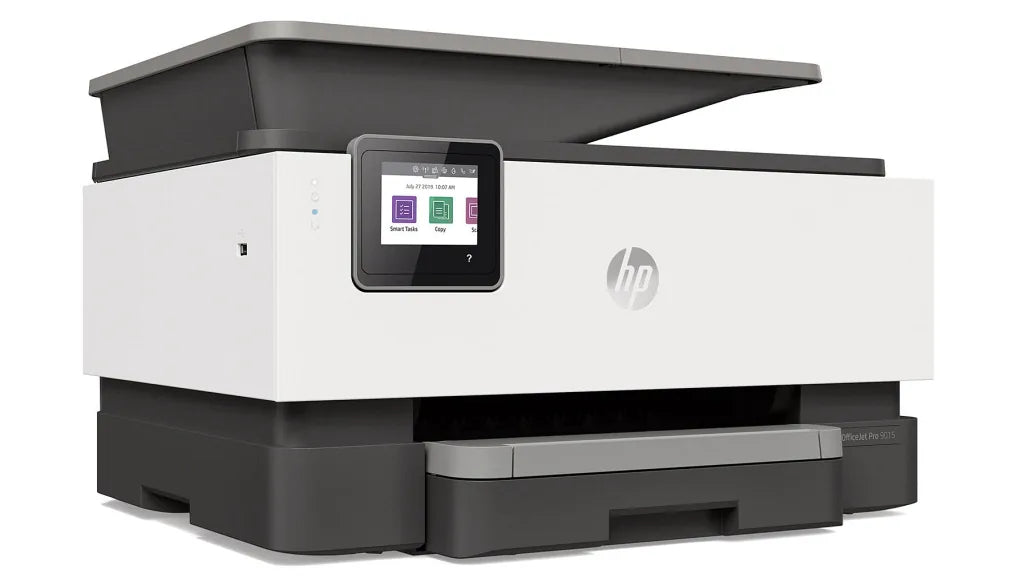HP OfficeJet Pro 9010e All-in-One Printer
This efficient inkjet is a small-office budget saver
-
PROS
- Fast
- Good print quality overall
- Competitive running costs
- Borderless printing
- 35-sheet auto-duplexing ADF
- Attractive, compact build
-
CONS
- Only one paper input source
HP OFFICEJET PRO 9015E ALL-IN-ONE PRINTER SPECS
| Automatic Document Feeder | |
| Color or Monochrome | Color |
| Connection Type | Ethernet |
| Connection Type | USB |
HP's OfficeJet Pro 9010e (A$279) is a color all-in-one printer designed for light- to medium-duty use in small workgroups and micro offices. Like its close competitor, the Editors' Choice-winning Epson WorkForce Pro WF-4720, the 9010e prints well at a relatively good pace, and it's loaded with the convenience and productivity features small offices need. When you combine this highly capable OfficeJet with a business-level subscription to HP's Instant Ink program (the 9010e comes with a six-month Instant Ink trial), you get a versatile, inexpensive-to-use AIO that's worthy of our Editors' Choice award.
Handsome and Feature-Packed
At 10.9 by 17.3 by 13.5 inches (HWD) and weighing 20 pounds, the 9010e is about 2.6 inches shorter and 6.5 pounds lighter than its higher-volume sibling, the HP OfficeJet Pro 9025. That's similar in heft and girth to the Epson WF-4720, slightly larger and heftier than the Canon Pixma TR8520 Wireless Home Office All-in-One Printer, and about 3.2 inches shorter than Brother's comparable MFC-J995DW. None of these printers will take up much room on your desktop.
Like the HP 9025, the 9010e comes with a 35-sheet auto-duplexing automatic document feeder (ADF) for copying, scanning, and faxing two-sided multipage originals without user intervention. The Epson WF-4720 also comes with a 35-page auto-duplexing ADF, whereas the Brother MFC-J995DW and the Canon TR8520 have ADFs that hold only 20 sheets, and neither can scan or copy two-sided pages without your having to flip the originals manually.

The 9010e's entire control panel consists of a somewhat small (2.7-inch) touch screen with no supporting buttons or navigation keys, as shown here.

While, for the most part, this little display is functional, some of the icons are a bit small to tap or swipe comfortably. The good news is that nearly everything that you might configure, monitor, or perform from the control panel is also accessible via HP's Embedded Web Server (shown below), which comes loaded in the firmware on most of the company's printers.

You can also generate reports for assessing usage and calculating ink and paper costs. Speaking of paper, the 9010e holds 250 sheets, as does the WF-4720, whereas the TR8520 holds up to 200 sheets, and the MFC-J995DW holds only 101 sheets, split between a 100-sheet cassette and a one-sheet override tray.

The 9010e's maximum monthly duty cycle is 25,000 pages, with a recommended monthly volume of 1,500 pages, which is at the higher end of the competitors mentioned here.
Myriad Connectivity Options
The 9010e's standard connectivity interfaces are Ethernet, Wi-Fi, connecting to a single PC via USB 2.0, and Wi-Fi Direct, a peer-to-peer network protocol for connecting your mobile devices to the printer without either it or them being part of a network. Other mobile connectivity consists of Apple AirPrint, Mopria, and HP Smart App. That last one, Smart App, provides drivers and a standard interface for connecting and managing HP printers across several various platforms, including Android, Windows, macOS, and iOS.

You can also print from and scan to USB thumb drives via the port located on the left side of the chassis, as shown here.

Security on the OfficeJet Pro 9010e includes a built-in firewall for controlling unwanted traffic, secure Wi-Fi Direct, and secure boot with self-healing Wi-Fi. You can also lock and password-protect the control panel and the Embedded Web Server. And, as do most other business printers, the 9010e allows you to encrypt Embedded Web Server data with secure socket layer (SSL) certificates.

Fast Performance
HP rates the 9010e at 22 pages per minute (ppm), which is the same as the OfficeJet Pro Premier and 2ppm slower than the 9025. I timed it over an Ethernet connection from our standard Intel Core i5-equipped testbed PC running Windows 10 Professional. During the first phase of our benchmarking tests, the 9010e printed our 12-page Microsoft Word text document at a speed of 22ppm, matching HP's rating and falling slightly behind the 9025 by 2.9ppm. The 9010e's score beat the Epson WF-4720 by 2ppm, outpaced the Brother MFC-J995DW by 11.5ppm, and came in faster than the Canon TR8520 by 9.2ppm.
For the next part of our benchmarking regimen, I timed the 9010e as it churned through several colorful and complex Adobe Acrobat and Microsoft Excel and PowerPoint documents and handouts containing charts, graphs, and other business graphics. Then, I combined those scores with the results from printing the 12-page text document in the previous paragraph and came up with a score of 15.5ppm for printing our entire suite of test documents. That score beat all the other AIOs mentioned here.
Finally, I finished up the testing by printing our detailed and brilliantly colored 4-by-6-inch test snapshots several times and came up with an average of 12 seconds. That's a little faster than the other AIOs mentioned here.
Near-Laser Quality
As I said about the 9025, the 9010e's output quality, especially text, is near perfect, rivaling a good color laser AIO. I saw none of the fuzziness (even with magnification) sometimes associated with fonts printed in ink, rather than toner, and characters were well-shaped and highly legible, even at small point sizes, making the text more than acceptable for even the most exacting business applications.
The Excel and PowerPoint charts and other business graphics looked good, too, though, I did see occasional artifacts that looked like 0.5-point vertical rules that ran the length of the content. They looked like they correspond with the width of the printhead and appear each time the printhead starts a new row. The good news is that the artifacts are not distracting.
While the 9010e's images are not quite consumer-grade-photo-printer quality, the ones I printed were more than passable for most in-house business reports, and even external marketing pictures of, say, simple product poses or perhaps to showcase real estate.
Reasonable Running Costs
Nowadays, all four of the major inkjet printer makers offer discount ink solutions on many of their printers, and, if you print enough, all four options will save you money on the per-page price of ink. HP's answer is Instant Ink. First, though, let's look at what the 9010e costs to use without an Instant Ink subscription. (Note that the 9010e includes a six-month Instant Ink trial.)
If you buy the highest-yield XL ink cartridges (2,000 pages monochrome and 1,600 pages color) for this AIO, each monochrome page will cost you about 2.2 cents and each color print will run about 8.8 cents. Subscribing to the company's highest-yield Instant Ink subscription (700 pages for $24.95 per month, with each additional 10 to 15 pages for $1), each page will cost you 3.5 cents.
That means any page—from a double-spaced black text manuscript page with about 5 percent ink coverage to a letter-size borderless photo with 100 percent coverage—will cost the same. Hence, it is with colorful, content-heavy pages that Instant Ink delivers the best value. HP offers Instant Ink subscriptions down to 15 pages per month for 99 cents a month, but if that's all you need, this is too much printer.
By comparison, the Epson WF-4720's running costs are 2.7 cents monochrome and 8 cents color. The Canon TR8520, a five-ink printer, will run you significantly more than that. And the Brother MFC-J995DW, one of the company's INKvestment Tank models, will run you just less than 1 cent for black pages and slightly less than 5 cents for color.
Little to Dislike
Our only cause for pause with the OfficeJet Pro 9010e is that it has just one paper input source. Otherwise, the 9010e prints well, it's fast, and its running costs are reasonable. If you need more robust paper capacity, the OfficeJet Pro 9025 comes with two 250-sheet paper trays. But if your small office's print and copy requirements are more modest, the OfficeJet Pro 9010e is a solid performer that's packed with features, and thus rates our Editors' Choice award.



